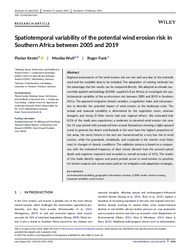Spatiotemporal variability of the potential wind erosion risk in Southern Africa between 2005 and 2019
Persistent URL: http://resolver.sub.uni-goettingen.de/purl?gldocs-11858/10920
 |
Dokument öffnen: |
Regional assessments of the wind erosion risk are rare and vary due to the methods used and the available data to be included. The adaptation of existing methods has the advantage that the results can be compared directly. We adopted an already successfully applied methodology (ILSWE—applied in East Africa), to investigate the spatiotemporal variability of the wind erosion risk between 2005 and 2019 in Southern Africa. The approach integrates climatic variables, a vegetation index, and soil properties to describe the potential impact of wind erosion at the landscape scale. The annual and seasonal variability is determined by the vegetation cover, whereas droughts and strong El Niño events had only regional effects. We estimated that 8.3% of the study area experiences a moderate to elevated wind erosion risk over the 15‐year period with annual and inter‐annual fluctuations showing a slight upward trend. In general, the desert and drylands in the west have the highest proportion of risk areas, the moist forests in the east are characterized by a very low risk of wind erosion, while the grasslands, shrublands, and croplands in the interior most likely react to changes of climatic conditions. The validation process is based on a comparison with the estimated frequency of dust storms derived from the aerosol optical depth and angstrom exponent and revealed an overall accuracy of 65%. The results of this study identify regions and yearly periods prone to wind erosion to prioritize for further analysis and conservation policies for mitigation and adaptation strategies.
Statistik:
ZugriffsstatistikSammlung:
- Geographie, Hydrologie [454]
Schlagworte:
environmental modellinggeographic information systems
ILSWE model
remote sensing
temporal variability
wind erosion

